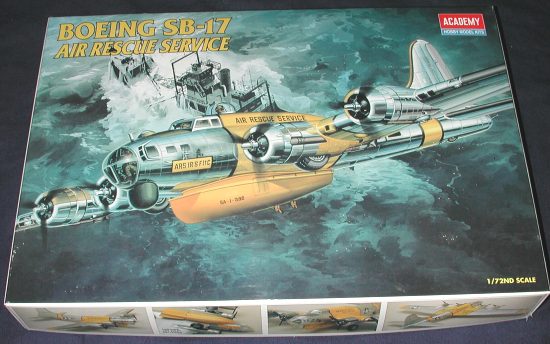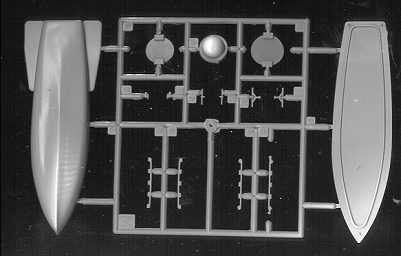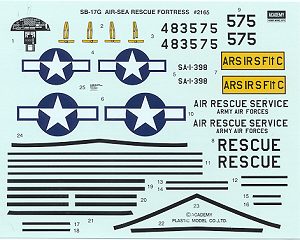
|
KIT: |
Academy 1/72 SB-17G |
|
KIT # |
2165 |
|
PRICE: |
$27.00 |
|
DECALS: |
One aircraft |
|
REVIEWER: |
|
|
NOTES: |

|
HISTORY |
The B-17 Flying Fortress was one of those planes that was in production from the beginning of WWI until nearly the end. In fact, there were so many built, that many of them went straight from storage to the smelter. The aircraft was built in many variants, but one of the more interesting was the air-sea rescue version, the SB-17G. This was basically a regular B-17G that had all its armament removed, the bomb bays sealed and additional parts added to it for the rescue role.
These additions included a large life boat (with stabilizing fins so it would hit the sea and not sink), a search radar where the chin turret would normally fit, and additional radios. In place of the gunners were observers. A contract for 300 modified aircraft was placed with Higgins Boats (who also made PT boats). The boat was a modified version of an RAF launch that was lowered to the sea by parachutes. Upon alighting on the waves, rescue lines were shot from the side of the boat by small rockets so that survivors would have a line to haul themselves into the boat. The boat itself was not only powered by a small engine, but also had sails so that in case no nearby ship was available, they could move in the direction of land or other rescue.
The first plane was delivered in early 1945 with the first use occurring in April 1945 off the coast of Denmark. Though initially armed, the SB-17G gradually lost its armament as the threat waned. During the Korean war, however, some armament was restored as the North Koreans would fire on any aircraft regardless of its benevolent mission. The SB-17G was in service until 1956 when the last of them were withdrawn and scrapped.
|
THE KIT |

This kit is exactly as the B-17G previously reviewed. IIf you visit that preview, you can see the sprues for the kit. The only difference in the plastic is the inclusion of a single sprue that includes the boat and various blanking plates as you can see from the image above. Construction of the model should be a bit simpler as there is no need to hassle with turrets .
 The instructions are quite
similar to the B-17G kit, even as far as showing some items that may not be
needed on this kit (like the bomb bay). You will have to do a bit of cutting as
this aircraft has staggered windows and that window will have to be opened on
the starboard side. You have optional observers windows and that is about it.
The instructions are quite
similar to the B-17G kit, even as far as showing some items that may not be
needed on this kit (like the bomb bay). You will have to do a bit of cutting as
this aircraft has staggered windows and that window will have to be opened on
the starboard side. You have optional observers windows and that is about it.
There are only one set of decals and that is for a generic SB-17G. I'm sure that the only difference between them were the serial numbers. However, there are large areas of yellow that will need to be painted on this one. The black bands around those areas are supplied on the decal sheet. Academy decals are not too bad, which is good as I don't think there are any aftermarket options for this plane. I would point out that the B-17 had fabric control surfaces so those need to be painted a different shade from the surrounding natural metal. To my knowledge, these planes were not painted in aluminum lacquer, but if anyone has contrary information, I'd like to hear it.
|
CONCLUSIONS |
I have not built any of the Academy B-17 kits, but a number of modelers have and highly recommend them as being more accurate than the Hasegawa versions. The kit looks pretty straight-forward so should provide no real problems.
Scott Van Aken
If you would like your product reviewed fairly and quickly by a site that has well over 150,000 visitors a month, please contact me or see other details in the Note to Contributors.